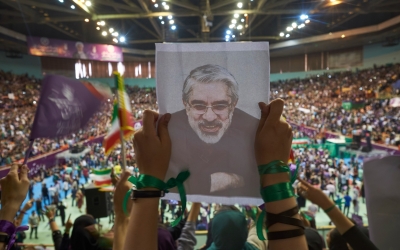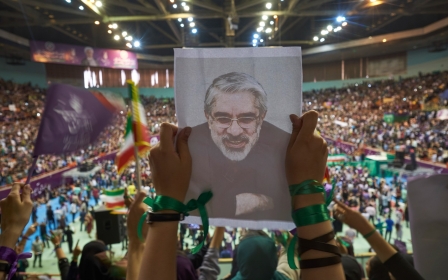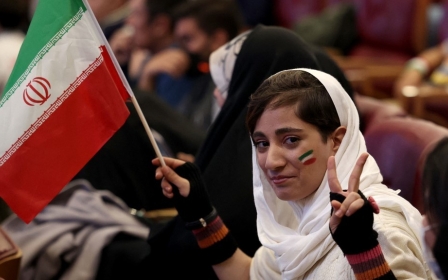Iran: Who is poisoning hundreds of schoolgirls?

Hundreds of schoolgirls in Iran have been hospitalised in recent weeks after being poisoned by what officials have described as an "intentional" gas attack.
Although incidents have been reported across the country, the majority of cases have centred around the holy city of Qom.
BBC Persian reported that as many as 800 students in Qom had been poisoned so far, and that a number of cases had also been detected in the capital, Tehran. Younes Panahi, a deputy health minister, told media that the poisonings were likely intentional - though he later claimed he was misquoted - while Mohammad Jafar Montazeri, the attorney general, has also described them as “probably intentional”.
'Of 550 people, only four students come to the school. The students are also terrified'
- Anonymous teacher
A doctor who treated some poisoned students told Middle East Eye the victims had "smelled something like the smell of sewage and salt, and had symptoms of dizziness, nausea and difficult breathing".
He added that a number of those he treated said they had "seen a suspicious thing thrown inside the school".
New MEE newsletter: Jerusalem Dispatch
Sign up to get the latest insights and analysis on Israel-Palestine, alongside Turkey Unpacked and other MEE newsletters
Yet so far, no one has been able to pinpoint who might be responsible, with some suggesting an attempt by ultra-conservatives to disrupt the education of girls and others pointing to anti-government opposition groups.
MEE spoke to a teacher in one of the schools affected by the poisoning. The teacher, who asked to remain anonymous, said two of her colleagues had also been hospitalised.
"The smell of the poison is like a rotten smell, but it is not gas - it is close to gas smell and at the same time it is something like a thick and pungent smell," she explained.
“The students faced severe coughs and difficulty in breathing and some were hospitalised.”
Iran's health ministry has been keen to stress that the effects of the poison have been mild, primarily causing "muscle weakness, lethargy, and nausea for a few hours”.
However, the repeated incidents have left parents deeply worried about sending their children to school, with the lack of information about the nature of the poison - and the culprits - further heightening fears.
“Of 550 people, only four students come to the school. The students are also terrified," said the teacher.
"The poison effects are to the extent that some of the students aren’t able to walk for a few days.”
'Extremist' attacks?
A number of theories have spread about the possible motives for the poisoning of schoolgirls. A popular one is that religious fundamentalist groups may be attempting to prevent the education of women and girls.
One conservative cleric based in Qom, speaking on condition of anonymity, said he believed it could be the work of "extremists" inspired by the Taliban in neighbouring Afghanistan.
“The number of such extremists is not too much and they can mostly be found in Mashhad, Shiraz, Qom and Isfahan, but they are really a little minority," he said.
He said these groups viewed the education of girls as spreading "corruption" and undermining both family and Islamic values.
“Such persons' perception of the religion is reactionary, ridiculous and unwise," he added.
Other religious and political figures concurred with this theory.
Mohammad Ali Abtahi, a cleric who was a senior figure in the reformist government of Mohammad Khatami, compared the possible culprits to the Africa-based militant group Boko Haram.
"Extremism, especially the religious ones, are the biggest danger to all societies," warned Abtahi, while calling on the security apparatus to identify and arrest the extremists.
Meanwhile, Masoumeh Ebtekar, former vice president for women and family affairs, tweeted that the police and judiciary needed to act "immediately" and compared the incidents to a series of acid attacks in the city of Isfahan in 2014, which allegedly targeted women not wearing "appropriate" hijab.
Counterterrorism calls
A number of people have called on the government to treat the poisoning as terror related and launch counterterrorism investigations.
According to the state-backed Fars News Agency, the security services arrested three suspects on Tuesday in connection with the poisoning.
Fars said there were "unconfirmed" reports linking the poisonings to the Mojahedin-e-Khalq (MEK), an Iranian opposition group dedicated to the overthrow of the Islamic Republic.
Although the MEK - who initially supported the 1979 Islamic Revolution, before falling out with the post-Shah administration - carried out numerous deadly bomb attacks in the country in the 1980s, in recent decades they have focused primarily on lobbying foreign governments and campaigning internationally against the Islamic Republic.
On Wednesday, the state-backed Tasnim news agency said there had been another gas attack in the northern city of Ardabil which had forced the hospitalisation of 108 students. The news agency also reported further poisonings at three schools in Tehran.
The ambiguity around the attacks and the lack of information from the government have stoked anger across the country.
Parents have protested outside Qom's governorate building, calling for more to be done to protect their children.
The poisonings have also come in the wake of months of mass demonstrations that focused on the treatment of women in the country, sparked by the death of Kurdish woman Mahsa Amini in custody following her arrest for "inappropriate hijab".
This article is available in French on Middle East Eye French edition.
Middle East Eye delivers independent and unrivalled coverage and analysis of the Middle East, North Africa and beyond. To learn more about republishing this content and the associated fees, please fill out this form. More about MEE can be found here.





